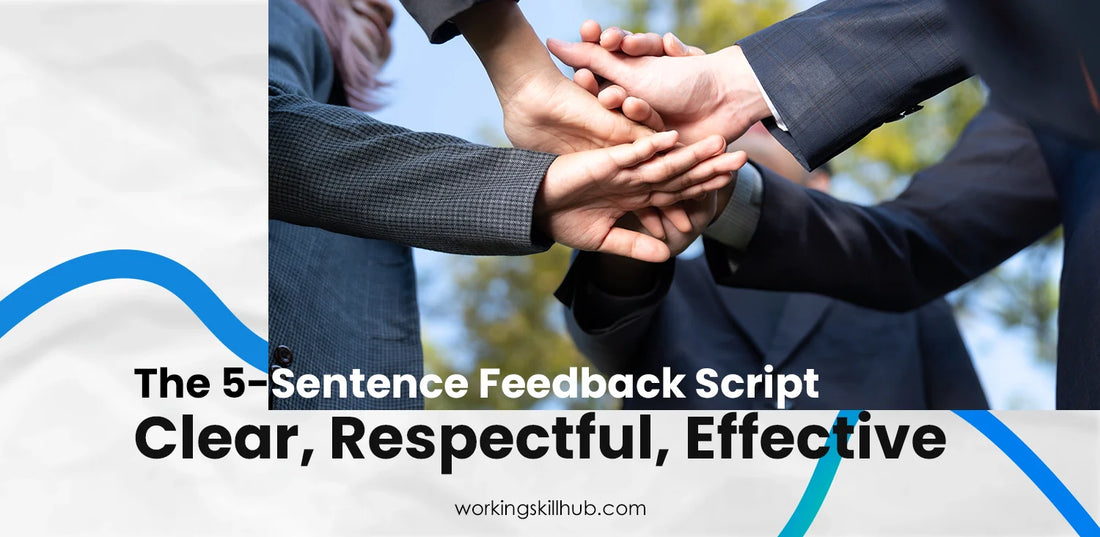When you need to give constructive feedback, use this five-sentence structure to avoid defensiveness, keep the conversation productive, and motivate real change. It’s simple, respectful, and works in professional or personal settings.
At a glance — the five sentences
-
Sincere Appreciation Hook — start with a specific praise.
-
Indirect Observation — name the issue gently, using “I” or “we.”
-
Collaborative Question — invite their view or solution.
-
Encouragement Boost — express confidence in their ability to improve.
-
Benefit Close — end with what they personally gain.
-
It opens with safety (praise), so the listener doesn’t feel attacked.
-
It avoids “but” or direct blame, which cancels earlier praise.
-
It engages the person to propose solutions, which increases buy-in.
-
It reinforces capability and shows respect for their identity.
-
It closes by linking change to a clear personal benefit — people act when it matters to them.
Detailed script
Sentence 1 — Sincere Appreciation Hook (Novocain)
Goal: Soften the moment and show genuine respect.
How to say it: Thank them for a specific action or quality. Avoid vague praise.
Template: “Thanks for the work you did on [project/task]. I especially appreciated [specific trait/result].”
Example: “Thanks for the proposal you prepared for the client. I especially appreciated how thorough the market research was.”
Sentence 2 — Indirect Observation (Avoid “but”)
Goal: Point out the problem without attacking. Use “I” or “we” to reduce defensiveness.
How to say it: State the observation briefly and neutrally; if useful, normalize the difficulty by admitting you’ve faced it too.
Template: “I noticed [issue]. I sometimes struggle with that myself when [context].”
Example: “I noticed the conclusions section could be clearer. I sometimes rush that part myself when deadlines are tight.”
Alternative phrasing: Reframe the mistake as an opportunity for a different use (e.g., “This report would make an excellent internal memo.”)
Sentence 3 — Collaborative Question
Goal: Invite ownership and ideas so the person helps solve the problem.
How to say it: Ask an open question that focuses on improvement.
Template: “What do you think would be the most helpful next step?” or “How would you approach fixing this for next time?”
Example: “To make the conclusion clearer next time, what change would you suggest we make to the outline?”
Why it helps: People are more likely to follow solutions they helped create.
Sentence 4 — Encouragement Boost
Goal: Reinforce belief in their ability; make the fix feel doable.
How to say it: Be specific about the skill or past success you trust.
Template: “I know you have the skills to handle this. If we adjust [small detail], it should be easy to fix.”
Example: “You’ve handled tight deadlines well before—I’m confident a small outline tweak will clear this right up.”
Why it helps: Encouragement reduces shame and preserves motivation.
Sentence 5 — Benefit Close (Comm-YOU-nication)
Goal: End on a clear, personal benefit. Start with “you” or “we” to make the impact immediate.
How to say it: Tie the change to a visible gain they care about.
Template: “When you make this change, you’ll [personal benefit/result].”
Example: “When you tighten the conclusion, you’ll win stakeholder confidence faster and have a stronger case in meetings.”
Why it works: Framing results around the person triggers engagement and pride.
Quick checklist before you speak
-
Is the praise specific? ✔
-
Is the problem described without blame? ✔
-
Did I ask a question to invite their idea? ✔
-
Did I remind them of their capability? ✔
-
Did I end with a clear benefit to them? ✔
Tips & common pitfalls
-
Don’t use “but” after praise — it negates the compliment.
-
Do keep each sentence short. Long explanations invite debate.
-
Do match tone and timing — pick a private moment for sensitive feedback.
-
Do follow up later to acknowledge improvement — feedback is an ongoing loop.
Using this five-sentence “Novocain” method, you move the conversation from criticism to collaboration. It protects dignity, invites ownership, and makes change feel both possible and personally meaningful.


